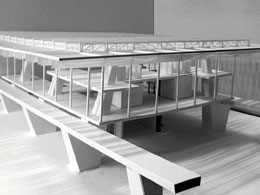STUDENTS PROJECTS
PROJECTS2012

21 January, 2013
Suburban Railway Station. Urban regeneration in Rouf, Athens, Greece
The main generator of this urban development, and the center of the regeneration area, is the suburban railway station.
Students: Ioannis Savvopoulos, Antonios Tsiligiannis
Supervisors: Andreas Kourkoulas, Ariadni Vozani
Faculty: National Technical University of Athens, Greece, School of Architecture
Date of Presentation: 17th July 2012

The suburban railway station in Rouf, Athens, Greece, is chosen as a regeneration tool for the degraded surrounding area. The station itself is designed to relieve the suburban passenger traffic from the Athens Central Railway Station. The thesis work attempts to bridge the regional and urban scale, with the architectural and building construction scale.
The metro, the train and the suburban rail are the modes that express the contemporary city, due to their ever-growing speed. The metro materializes the network within the urban fabric, whereas the train is the mode that defines the network within the national and transnational space. The suburban rail is the mode that bridges the gap between these two, servicing the supralocal mobility needs of a city. In the case of the city of Athens, upon completion, the suburban railway network will connect 3 passenger ports, the airport and 4 peripheral cities with the center of Athens.
The Rouf railway lot is situated between the railway station of the port of Piraeus and the Athens Central Railway Station. In a distance lesser than 1 km there are 2 metro stations (Kerameikos, Petralona), while in a distance of 1,5 km the regeneration of Elaionas is planned. Situated between the historic center and the city's natural expansion towards the west, Rouf can become the suburban transit station of Athens. Furthermore, it provides clear views towards the historic hills of the Acropolis, Filopappou and Lycabettus. The station attempts to become a new landmark for the city.
The impassable border that the railway lines consist is eliminated here by elevating the lines by 8 meters, reuniting the nowadays separated neighbourhoods. The lifting of the lines aims to make them a landmark for the city, as well as providing the passengers of the train with a synopsis of the city. Thus, the creation and rearrangement of streets is enabled, while the site is serviced by public transport. The creation of pedestrian/bicycle paths under the lifted rail lines reunites the formerly separated neighbourhoods. The union of green spaces between Elaionas and the archeological sites of the center is planned, making the station a node among green areas.
A smooth artificial hill is created, peaking at the center of the lot 4,80 meters higher than the natural soil. This hill leads the passenger towards the central atrium of the station. It is planted, thus giving the impression that nature has penetrated the building. After having arrived at the central atrium, the passenger has basically arrived at the most central point of the building. From there the rail lines course can be easily understood, since the elevated lines and the platform level surround the central atrium. The platform level is connected to the ground via two big catapult-like axes which direct the movement from the hill's peak of the central atrium. After arriving at the first floor, escalators and elevators lead to the second floor, where the cafeterias are located. The entire building is covered by a canopy with metallic framework, which gives the impression of hovering over the construction. This canopy has a mechanism of sails underneath it, serving in controlling the natural light and the falling of the shade.
In the case of the railway station of Rouf, the intention is to give the feeling of a Mediterranean cathedral of light, while at the same time being completely Doric in its form. The game of light and shade is the characteristic element of the building.



Related articles:
- Urban reconstruction using the train ( 11 March, 2011 )
- Central bus station in the area of Eleonas - Botanikos ( 26 April, 2011 )
- Radical reconstruction of Roma settlement in Komotini ( 21 June, 2014 )
- Metro station “KERAMIKOS” ( 29 June, 2012 )
- Gullesfjord Weight Control Station ( 23 October, 2012 )
- Suburban Railway Station. Urban regeneration in Rouf, Athens, Greece ( 21 January, 2013 )
- Interventions on the urban railway stations of the network Patras - Rio ( 13 February, 2013 )
- In.Bu.S, Intercity Bus Station in Chania, Crete ( 02 April, 2013 )
- Railway Station Complex in St. Denis district in Patras, Greece ( 11 April, 2013 )
- Souda Port Passenger Station, Souda Bay,Chania,Crete ( 10 June, 2013 )
- Railscapes: Tracing routes of rail history ( 17 March, 2014 )










